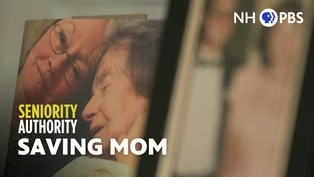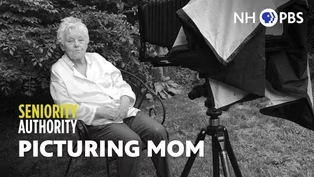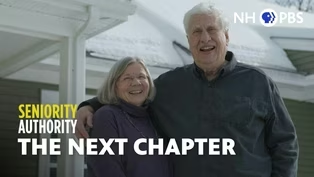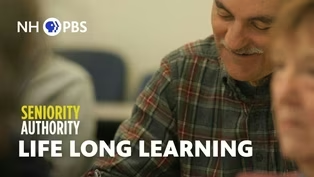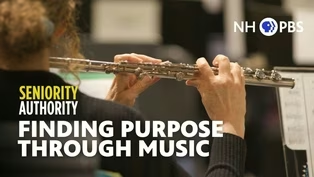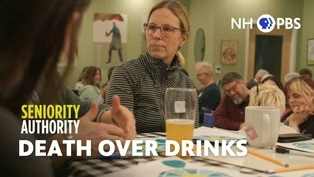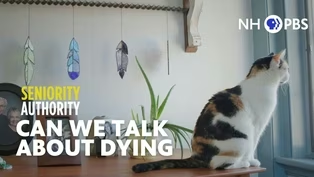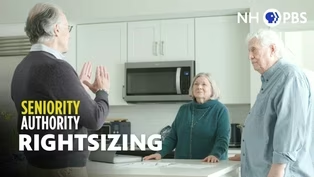Seniority Authority
Picturing Mom
Clip: Season 1 | 4m 4sVideo has Closed Captions
A daughter turns grief into art as her mother fades, finding love through the lens.
When her mother’s dementia began to erase the woman she’d always known, photographer Cheryle St. Onge did what artists do—she picked up her camera.Through shared moments in the garden, in the sunlight, and behind the lens, Cheryle discovered that making art wasn’t about holding on to her mother—it was about learning how to let go with love.
Problems playing video? | Closed Captioning Feedback
Problems playing video? | Closed Captioning Feedback
Seniority Authority is a local public television program presented by NHPBS
Seniority Authority
Picturing Mom
Clip: Season 1 | 4m 4sVideo has Closed Captions
When her mother’s dementia began to erase the woman she’d always known, photographer Cheryle St. Onge did what artists do—she picked up her camera.Through shared moments in the garden, in the sunlight, and behind the lens, Cheryle discovered that making art wasn’t about holding on to her mother—it was about learning how to let go with love.
Problems playing video? | Closed Captioning Feedback
How to Watch Seniority Authority
Seniority Authority is available to stream on pbs.org and the free PBS App, available on iPhone, Apple TV, Android TV, Android smartphones, Amazon Fire TV, Amazon Fire Tablet, Roku, Samsung Smart TV, and Vizio.
Providing Support for PBS.org
Learn Moreabout PBS online sponsorshipSo my grandmother died at home.
My.
My aunt died at home.
My great grandmother died at home.
And my mother was fully intending to die at home.
Like that was something that was discussed, like, please don't put me in a nursing home.
And I think when you grow up hearing that, I mean, you really don't have any choice.
Being an only child, I had a really close relationship with my mom.
And so she lived on this property for about 20 years as a totally functioning person.
She had a career.
She did a lot of gardening.
You know, it was very close to her grandchildren.
It was about as wonderful a co-mingling of ages as you can imagine.
My mother was really the one that was kind of saying, like, I'm having trouble remembering how to get home, or there's a woman who calls me and I think she's my sister and her doctor.
He just said, dementia is one of those things.
We're not really sure how it's going to unfold.
So there was no roadmap, there was no promise.
But there also wasn't that sense that there should be.
It was like it was like he was explaining dementia as something that was making me not responsible for the national debt.
We're here together and we love each other, and we'll figure it out as we go.
And there was a lot of tears and a lot of sadness.
I really relied on a lot of my friends, which happened to be artists.
I had a couple friends who I think were teasing me and said, okay, so we want to see some pictures of your mother.
We've been telling you for a couple of months now.
You should be making pictures of your mother, and you don't want any part of that because I felt like it would be be like making pictures of a wounded bird.
But, you know, I sort of rose to the dare.
And so I told my mother, we're going to make a couple of pictures for Joanie and Mary Ellen, but she did this thing that I'll never forget.
She just kind of went like, oh, okay.
And I remember thinking, I don't know what just happened.
Like, you're this, you're like this.
This isn't you.
Somehow hearing the word picture and putting it all together, she sort of intrinsically kind of understood the 1950s of like, oh, let's put our best face forward.
And, and she kind of got into it and I, we looked at it together and she was like, who's that lady?
I shared a couple of them on Instagram or I posted them on Facebook or I sent them to friends and suddenly they were like, oh, wait, this is this is crazy.
Like, you should be making more of this.
And all of a sudden it was like these floodgates just opened up.
The more I share, the less pain I'll feel.
And then we also had something to do.
It, for me, it got me outside and it got me doing something with her.
I feel like I'm somebody who really likes to make things, build things.
I think for her it was helpful because she she was outside in the sun, you know, which is something that she innately loved.
She was outside still listening to birds and saying, like, did you hear that?
You know, that's that's a Jay.
That's chickadee.
Or we can pick blueberries and that's what we needed.
We needed some things to do to go outside and get some activity, get some fresh air, get away from sitting at the table and just thinking about how sad it all is.
Hospice was really good about saying to me, like, you had this great relationship.
And then all of a sudden she lost her ability to talk to you, and you have nothing in common anymore.
You didn't have any way to communicate.
And all of a sudden, the pictures and the art became the new way that you could communicate, and suddenly you're back to having a way to talk.
But, probably most days I just tried to not think about what it was going to be like when she wasn't here anymore.
And it's ironic, because I don't think I saw the pictures as, as something to hold on to.
I've certainly had people say to me like, it's so great that you have these pictures of your mother, because now that she's gone, and I think to myself, well, these aren't pictures of my mother.
My mother was a fully functioning human.
And these are pictures about a relationship between two people as one of them was dying.
That's what those pictures are about for me.
Video has Closed Captions
Clip: S1 | 3m 22s | When dementia changed everything, Carol found a new way to just be her mother’s daughter. (3m 22s)
Video has Closed Captions
Clip: S1 | 4m 4s | A daughter turns grief into art as her mother fades, finding love through the lens. (4m 4s)
Video has Closed Captions
Clip: S1 | 3m 14s | Mary Ellen and Richard find freedom in letting go (3m 14s)
Video has Closed Captions
Clip: S1 | 3m 38s | At any age, dance brings joy, confidence, and community—just ask Caroline’s class. (3m 38s)
Video has Closed Captions
Clip: S1 | 2m 50s | Curiosity never retires. Lifelong learners find joy, friendship, and purpose at OLLI. (2m 50s)
Video has Closed Captions
Clip: S1 | 4m 37s | They picked up instruments late in life and found joy, friendship, and new purpose. (4m 37s)
Video has Closed Captions
Clip: S1 | 3m 43s | Joe left finance to help seniors “right-size” their lives and rediscovered his purpose. (3m 43s)
Video has Closed Captions
Clip: S1 | 4m 28s | Who knew talking about death with strangers could teach you how to live more fully? (4m 28s)
Video has Closed Captions
Clip: S1 | 5m 29s | Laura’s loss sparks a movement to help others talk about death—and truly live. (5m 29s)
Video has Closed Captions
Clip: S1 | 4m | Meet one yogi who learned to age peacefully one breath, pose and moment at a time. (4m)
Preview: S1 | 20s | Cathleen Toomey tackles the real questions we all face as we grow older. (20s)
Preview: 9/15/2025 | 25s | Talking about aging and care with loved ones—expert tips to ease tension and plan with compassion. (25s)
The Power of Purpose (Preview)
Preview: 9/15/2025 | 20s | Bestselling author Chip Conley shows how purpose can transform life after retirement (20s)
Preview: 9/12/2025 | 20s | Author and activist Ashton Applewhite challenges ageism and shares simple ways to thrive. (20s)
Preview: 9/4/2025 | 20s | Discover how Hoarders and Filthy Fortunes host Matt Paxton says rightsizing frees time. (20s)
Providing Support for PBS.org
Learn Moreabout PBS online sponsorshipSupport for PBS provided by:
Seniority Authority is a local public television program presented by NHPBS
